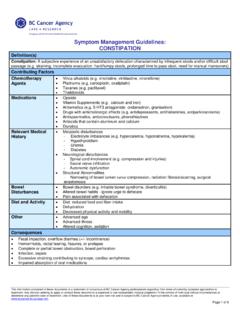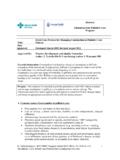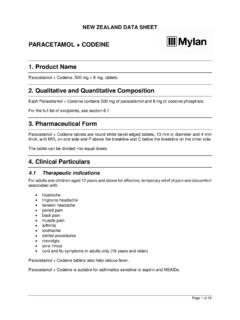Transcription of STRATEGIES FOR THE MANAGEMENT OF OPIOID …
1 52 Vol. 5, No. 2nJune 2008 ABSTRACTO pioids have the potential to produce abroad range of adverse events, including seda-tion, respiratory depression, nausea, vomiting,and constipation . Many of these adverse effectsdiminish over time as tolerance develops,although tolerance to some effects develops veryslowly or not at all. The adverse event profiles ofthe various opioids are generally similar whenadministered at equianalgesic doses, althoughindividual patients may respond differently to thevarious agents. In addition, some opioids (eg,meperidine and propoxyphene) are associatedwith relatively high rates of adverse events, andare not recommended as first-line and nausea are common with opioidinitiation or dose escalation, and may be exacer-bated by a number of other medications orcomorbid conditions.
2 Opioids produce a numberof central and peripheral effects that contribute tonausea and vomiting. constipation is very com-mon with OPIOID therapy, and is generally notsignificantly relieved by the development of toler-ance. A bowel regimen that includes a stool soft-ener and a stimulant laxative is essential for everypatient who is using an OPIOID analgesic. Bulk-forming laxatives arenot recommended forpatients taking opioids. STRATEGIES to reduce opi-oid-induced adverse events include cautiousdosage titration, dose reduction, MANAGEMENT of specific symptoms, OPIOID rotation, or using a dif-ferent route of administration. OPIOID conversionmay be calculated using published conversioncharts, but must be individualized on the basis ofthe patient s treatment history and other clinical characteristics.
3 Pharmacists perform many essen-tial roles in the MANAGEMENT of acute pain,including patient education, ensuring the accura-cy and safety of prescribed medications, and per-forming regular assessment of the efficacy andsafety of OPIOID therapy.(Adv Stud ;5(2):52-57)An important goal of pain MANAGEMENT is toprovide adequate pain relief while ensuringpatient safety. Opioids are powerful anal-gesics that are generally well tolerated forthe treatment of acute pain in many different clinicalsettings. They also have the potential to produce abroad range of adverse effects, including sedation, res-piratory depression, nausea and vomiting, and consti-pation. OPIOID -induced adverse events are oftendifficult for patients to tolerate, and may interfere withtreatment adherence and relief from pain.
4 However,tolerance to many of these adverse events develops rel-atively quickly, and others may be effectively managedby adjunctive therapies, many of which are availablewithout a prescription. Patient education is essential toreduce the risk of OPIOID -related adverse events and tohelp patients attain the greatest possible pain factors influence the risk of OPIOID -relatedadverse events. There is little evidence that any particu-lar OPIOID is associated with a significantly lower risk ofadverse events in general when administered atequianalgesic doses, although the responses of individ-ual patients to the different agents may events are dose related, including respiratorydepression and sedation,2whereas other adverse effects(eg, constipation ) are less closely related to the opioiddose.
5 Many patients take other medications that pro-duce additive or even synergistic adverse effects. Patientfactors that influence the risk of adverse effects includegenetic variability, comorbid conditions, and age. Olderpatients in particular are more likely to experience painREVIEWSTRATEGIES FOR THE MANAGEMENT OF OPIOID -INDUCED ADVERSE EFFECTS Mary Lynn McPherson, PharmD, BCPS, CDE**Professor, University of Maryland School of Pharmacy,Baltimore, correspondence to: Mary Lynn McPherson,PharmD, BCPS, CDE, Professor, University of Mary-land School of Pharmacy, 20 N. Pine Street, Pharmacy Hall, Room 426, Baltimore, MD 21201. E-mail: of Tennessee Advanced Studies inPharmacy n53 REVIEWdue to higher rates of surgical procedures, injuries, orpainful medical conditions; they are more likely to havecomorbid conditions that may complicate therapy; andthey are more likely to experience adverse effects with renal impairment may havehigher rates of adverse events with opioids that producetoxic metabolites that are renally excreted.
6 For example,renally excreted metabolites of morphine or meperidine(morphine-3-glucuronide and normeperidine, respec-tively) contribute to the adverse events associated withthese general, STRATEGIES to reduce adverse effectsinclude reducing the OPIOID dose, symptom manage-ment by the addition of other medications, OPIOID rota-tion, or switching to another route of dose reduction is usually attempted for patientswith well-controlled pain who are experiencing dose-related adverse effects. Numerous symptomatic treat-ments are used for patients with OPIOID -related adverseeffects, several of which are described in detail , polypharmacy also increases the risk of druginteractions and new adverse effects. Many studies havedemonstrated that rotation to a different OPIOID oftenhelps to improve tolerability, which may reflect patient-to-patient variation in genetics, comorbid conditions, oraccumulation of ,5 Individual opioids mayalso possess subtle differences in their agonist or antag-onist effects at different receptor subtypes that influencethe likelihood of adverse events.
7 This possibility is sup-ported by studies that have demonstrated incompletecross-tolerance to different commonly occurs with the initiation ofopioid therapy or with dosage increases, and may beaccompanied by transient drowsiness or cognitiveimpairment. The likelihood of sedation is increased byseveral comorbid medical conditions (eg, dementia,metabolic encephalopathy, and metastases of the brainin patients with cancer) or by other medications (eg,antidepressants, anticonvulsants, and muscle relax-ants).7 There are several options for the managementof OPIOID -related sedation, including assessing andmanaging any comorbid conditions that may con-tribute to sedation, discontinuing or reducing thedoses of other sedating medications, OPIOID rotation,or the addition of a psychostimulant (eg, caffeine, dex-troamphetamine, methylphenidate, or modafinil).
8 8 RESPIRATORYDEPRESSIONR espiratory depression with OPIOID treatment ispotentially the most dangerous OPIOID -related adverseevent, often occurring in first-time OPIOID users whoreceive a short course of oral to therespiratory effects of opioids usually develops within afew days to several weeks. Respiratory depression maybe managed by reducing the OPIOID dose or dosing fre-quency. In severe cases, an OPIOID antagonist may berequired to rapidly reverse respiratory , severe sedation is often a warning sign of anincreased risk of dangerous respiratory depression, andindicates the need for OPIOID dose reduction or anincreased period between may also complicate sleep apnea. A recentobservational study of 140 patients with chronic painwho were receiving stable doses of opioids included anassessment of a night s sleep using or central sleep apneaoccurred in 75% of the patients, which is significantlyhigher than the rate of sleep apnea among the generalpopulation (approximately 2% 4%).
9 An index ofapnea or hypopnea was directly related to the dailydosage of methadone, and was also higher in OPIOID -treated patients who received sleep apnea has primarily been studied inpatients with chronic pain, acute OPIOID treatment hasalso been shown to exacerbate sleep ,11 NAUSEA ANDVOMITINGN ausea and vomiting affect an estimated 30% to60% of patients who are treated with opioids, and aredescribed by patients as highly nausea and vomiting by several distinct mech-anisms. Nausea and vomiting are influenced by sever-al different sensory pathways that converge on a vomiting center in the brain includethe chemoreceptor trigger zone (CTZ), a region of thebrain that is especially sensitive to toxins; the vestibu-lar apparatus of the ear, which regulates balance andcauses nausea during motion sickness or in individualswith vestibular disease; and the vagus nerve and gas-trointestinal tract, which respond to gastric irritation,intestinal distention, or to stimulation of the gagreflex.
10 The opioids contribute to nausea and vomitingby activating all of these mechanisms, including stim-ulation of the CTZ, gastric stasis, and enhancedvestibular sensitivity. Tolerance to nausea and vomit-ing develops slowly. Nausea and vomiting may beexacerbated by comorbid conditions such as hypercal-cemia, increased intracranial pressure, or the use ofemetogenic drugs (eg, digoxin, antibiotics, iron, andcytotoxic agents). Options for the medical manage-ment of nausea and vomiting include dopamine antag-onists (eg, haloperidol and prochlorperazine),54 Vol. 5, No. 2nJune 2008serotonin antagonists, prokinetic agents (eg, metoclo-pramide), or agents that are used to treat motion sick-ness (eg, diphenhydramine and scopolamine).13-15 CONSTIPATIONC onstipation is among the most common adverseeffects of OPIOID therapy.









